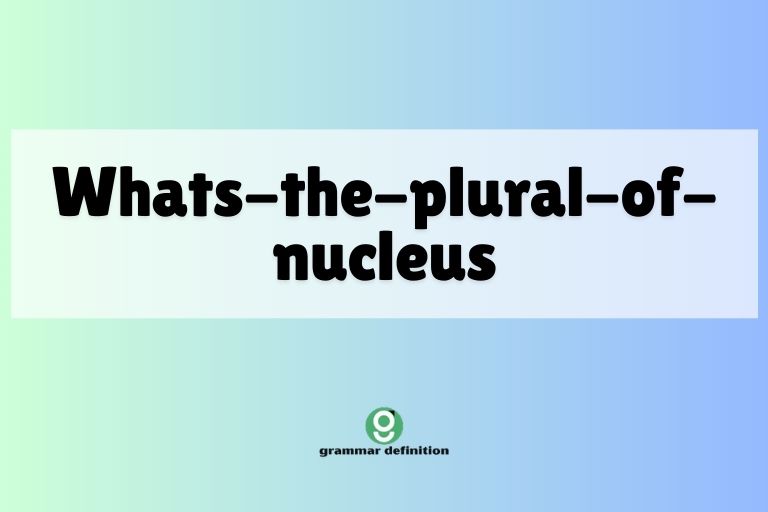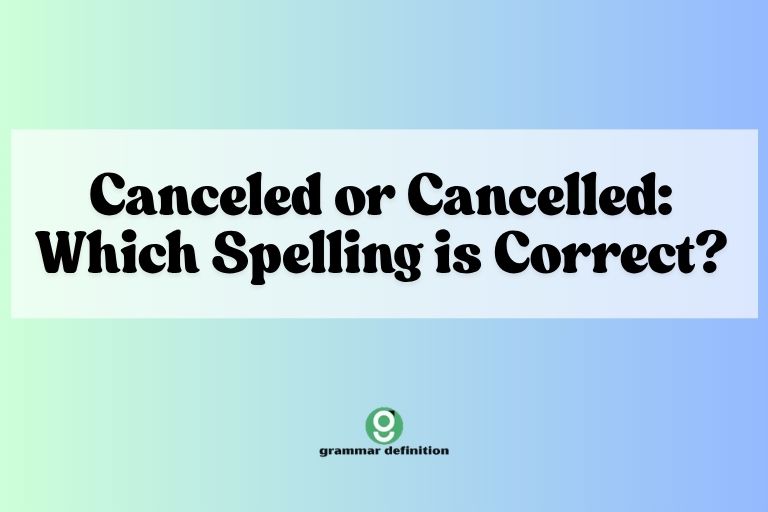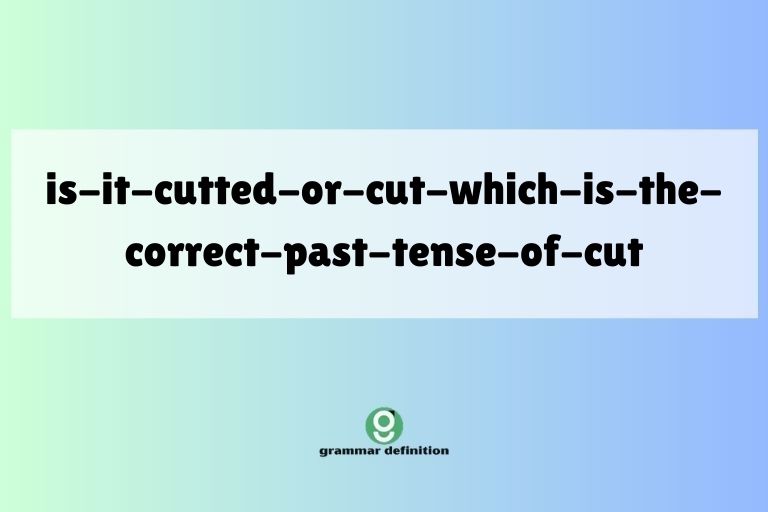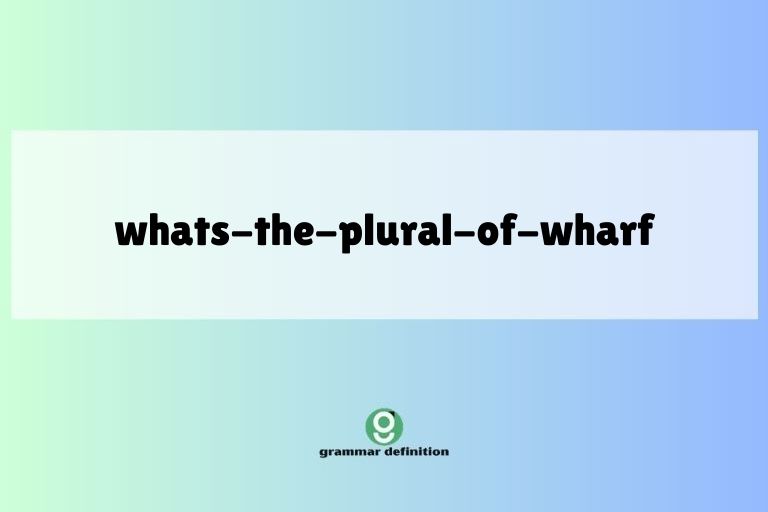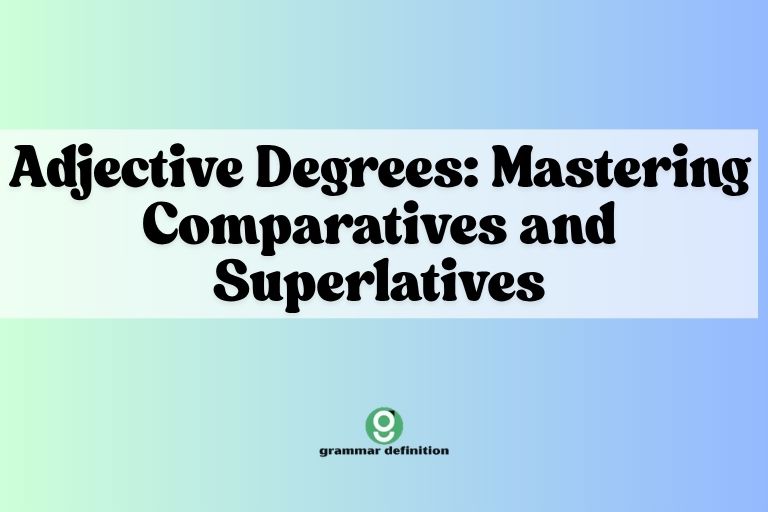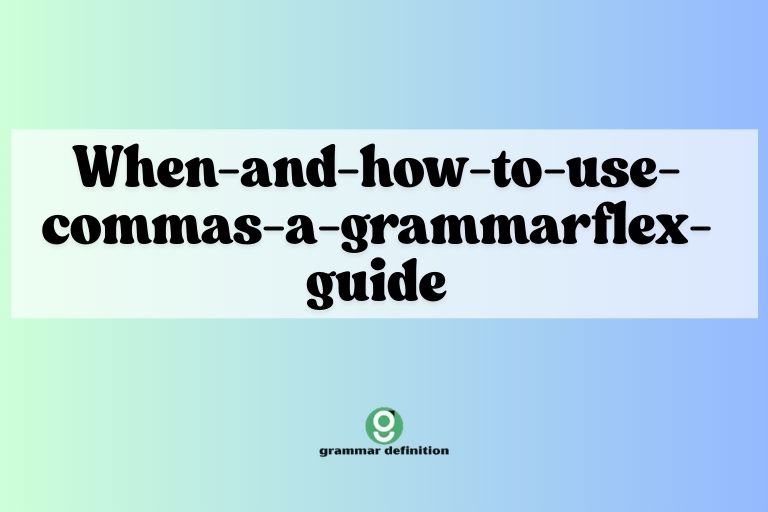Mastering Past Participle Phrases: Definition, Usage, and Examples
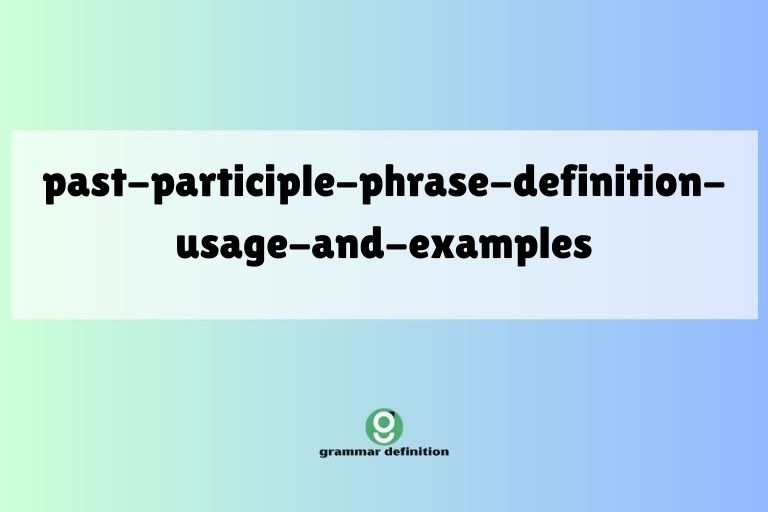
Past participle phrases are a crucial element of English grammar, adding depth and complexity to sentences. Understanding how to use them effectively can significantly improve your writing and comprehension skills.
This article provides a comprehensive guide to past participle phrases, covering their definition, structure, usage, and common mistakes. Whether you’re a student, a writer, or simply someone looking to improve your English, this guide will equip you with the knowledge and practice you need to master this important grammatical concept.
Table of Contents
- Introduction
- Definition of Past Participle Phrases
- Structural Breakdown of Past Participle Phrases
- Types of Past Participle Phrases
- Examples of Past Participle Phrases
- Usage Rules for Past Participle Phrases
- Common Mistakes with Past Participle Phrases
- Practice Exercises
- Advanced Topics
- Frequently Asked Questions
- Conclusion
Introduction
Past participle phrases are versatile tools in the English language, allowing for concise and descriptive writing. These phrases act as adjectives, modifying nouns or pronouns and adding detail to sentences.
Mastering their use is essential for anyone seeking to improve their writing style and grammatical accuracy. This article will guide you through the intricacies of past participle phrases, providing clear explanations, numerous examples, and practical exercises to solidify your understanding.
By the end of this guide, you will be confident in identifying and using past participle phrases effectively.
This guide is designed for learners of all levels, from those just beginning to explore English grammar to advanced students looking to refine their skills. Whether you’re preparing for an exam, writing a report, or simply aiming to communicate more effectively, understanding past participle phrases will be a valuable asset.
We’ll break down the concept into manageable parts, ensuring that you grasp the fundamentals and can apply them with confidence.
Definition of Past Participle Phrases
A past participle phrase is a group of words consisting of a past participle and any modifiers, complements, or objects. This phrase functions as an adjective, modifying a noun or pronoun in the sentence. The past participle is typically the third form of a verb (e.g., eaten, written, broken). It describes a completed action or a state of being resulting from a past action. These phrases add detail and context to the nouns they modify, making sentences more vivid and informative.
Past participle phrases can be identified by the presence of a past participle verb form and its related words, all working together to describe a noun. The phrase typically answers the question “which one?” or “what kind?” about the noun it modifies.
Recognizing these phrases is crucial for understanding sentence structure and meaning. Consider the following examples:
- The car, damaged in the accident, was towed away. (The phrase “damaged in the accident” modifies “car.”)
- Written in haste, the letter contained several errors. (The phrase “Written in haste” modifies “letter.”)
In both examples, the bolded phrases are past participle phrases that provide additional information about the nouns they modify. They function as adjectives, enriching the sentences with descriptive detail.
Classification and Function
Past participle phrases fall under the broader category of verbal phrases, which are phrases headed by a verb form that functions as a different part of speech. In this case, the past participle phrase functions as an adjective, modifying a noun or pronoun.
This classification highlights the dual nature of these phrases: they originate from verbs but operate as adjectives within the sentence structure.
The primary function of a past participle phrase is to provide descriptive information about a noun or pronoun. This information can relate to the noun’s state, condition, or origin.
By functioning as adjectives, past participle phrases add depth and detail to sentences, making them more engaging and informative. They allow writers to convey complex ideas concisely and effectively.
Understanding the classification and function of past participle phrases is essential for using them correctly. Recognizing their adjectival role helps in placing them appropriately within sentences and ensuring that they modify the intended nouns or pronouns.
This understanding also aids in avoiding common grammatical errors, such as misplaced or dangling modifiers.
Structural Breakdown of Past Participle Phrases
The basic structure of a past participle phrase consists of a past participle verb form and any related modifiers, complements, or objects. The past participle is the central element, and the other components provide additional information or context.
Understanding this structure is crucial for both identifying and constructing past participle phrases effectively.
A typical past participle phrase will include the following:
- Past Participle: The verb form indicating a completed action (e.g., broken, painted, forgotten).
- Modifiers: Adverbs or adverbial phrases that describe the past participle (e.g., carefully painted, badly broken).
- Complements: Words or phrases that complete the meaning of the past participle (e.g., written in ink, damaged by the storm).
- Objects: Nouns or pronouns that receive the action of the past participle (less common, but possible).
These elements work together to form a cohesive phrase that functions as an adjective. The order and arrangement of these elements can vary, but the past participle always remains the central component.
Common Structural Patterns
Several common structural patterns can be observed in past participle phrases. Recognizing these patterns can help you identify and construct these phrases more easily.
Here are some examples:
- Past Participle + Prepositional Phrase: Forgotten by everyone, the old house stood alone.
- Past Participle + Adverb: Neatly arranged, the books filled the shelves.
- Past Participle + Adjective: Well-respected, the doctor was known throughout the town.
- Past Participle Alone: Exhausted, the runner collapsed after the race.
These patterns demonstrate the flexibility of past participle phrases and their ability to convey a variety of meanings. By understanding these patterns, you can create more complex and nuanced sentences.
The following table illustrates some of these structural patterns with additional examples:
| Pattern | Example | Explanation |
|---|---|---|
| Past Participle + Prepositional Phrase | Covered in snow, the mountains looked majestic. | “Covered” is the past participle, and “in snow” is the prepositional phrase. |
| Past Participle + Adverb | Hastily written, the report contained several errors. | “Written” is the past participle, and “hastily” is the adverb. |
| Past Participle + Adjective | Well-prepared, the student aced the exam. | “Prepared” is the past participle, and “well-” is the adjective prefix. |
| Past Participle Alone | Dejected, he walked away. | “Dejected” is the past participle modifying “he.” |
| Past Participle + Adverb Phrase | Thoughtfully considered for days, the proposal was finally rejected. | “Considered” is the past participle, and “thoughtfully for days” is the adverb phrase. |
| Past Participle + Noun Phrase | Loved by many, the celebrity was always surrounded by fans. | “Loved” is the past participle, and “by many” is the noun phrase. |
| Past Participle + Infinitive Phrase | Equipped to handle any situation, the team was ready for the challenge. | “Equipped” is the past participle, and “to handle any situation” is the infinitive phrase. |
| Past Participle + Subordinate Clause | Inspired by what he had seen, the artist began his next masterpiece. | “Inspired” is the past participle, and “by what he had seen” is the subordinate clause. |
Understanding these structural patterns will allow you to craft more complex and descriptive sentences, improving the overall quality of your writing.
Types of Past Participle Phrases
While all past participle phrases function as adjectives, they can be categorized based on their specific role in the sentence and the type of information they convey. Understanding these different types can help you use them more effectively and avoid common grammatical errors.
Past Participle Phrases as Reduced Adjective Clauses
One common type of past participle phrase is a reduced adjective clause. An adjective clause is a dependent clause that modifies a noun or pronoun. It often begins with a relative pronoun such as who, which, or that. A past participle phrase can be formed by reducing an adjective clause, making the sentence more concise.
For example, consider the following sentence:
The book that was written by Hemingway is a classic.
The adjective clause “that was written by Hemingway” can be reduced to the past participle phrase “written by Hemingway”:
The book, written by Hemingway, is a classic.
The reduced phrase conveys the same information as the original clause but in a more concise manner. This type of past participle phrase is particularly useful for streamlining sentences and making your writing more efficient.
Past Participle Phrases in Absolute Phrases
Another type of past participle phrase appears in absolute phrases. An absolute phrase modifies the entire sentence rather than a specific noun or pronoun.
It typically consists of a noun or pronoun followed by a past participle phrase. Absolute phrases add additional information or context to the sentence as a whole.
For example:
The game finished, the fans left the stadium.
In this sentence, “The game finished” is an absolute phrase that provides context for the main clause. The past participle “finished” is part of this phrase, contributing to the overall meaning of the sentence.
Absolute phrases can add sophistication and nuance to your writing.
Descriptive Past Participle Phrases
The most common type of past participle phrase is simply a descriptive phrase that modifies a noun or pronoun. These phrases provide additional details about the noun, such as its state, condition, or origin.
They are often used to create vivid and engaging descriptions.
For example:
The house, painted blue, looked charming.
In this sentence, “painted blue” is a descriptive past participle phrase that modifies the noun “house.” It provides additional information about the house’s appearance, making the sentence more descriptive and engaging.
The following table illustrates the different types of past participle phrases with additional examples:
| Type | Example | Explanation |
|---|---|---|
| Reduced Adjective Clause | The car, damaged in the storm, was towed away. | Reduces the clause “that was damaged in the storm.” |
| Absolute Phrase | The work completed, they went home. | Modifies the entire sentence, providing context. |
| Descriptive Phrase | The cake, baked yesterday, tasted delicious. | Provides additional details about the cake. |
| Reduced Adjective Clause | The report, reviewed by the manager, was approved. | Reduces the clause “that was reviewed by the manager.” |
| Absolute Phrase | All things considered, it was a successful project. | Modifies the entire sentence, providing context. |
| Descriptive Phrase | The flowers, arranged beautifully, adorned the table. | Provides additional details about the flowers. |
| Reduced Adjective Clause | The painting, created by Van Gogh, is priceless. | Reduces the clause “that was created by Van Gogh.” |
| Absolute Phrase | The decision made, the team moved forward with the plan. | Modifies the entire sentence, providing context. |
| Descriptive Phrase | The mountain, covered in snow, was breathtaking. | Provides additional details about the mountain. |
| Reduced Adjective Clause | The song, sung by Adele, became a hit. | Reduces the clause “that was sung by Adele.” |
By understanding these different types of past participle phrases, you can use them more effectively to enhance your writing and communication skills. Each type serves a unique purpose, allowing you to convey information in a precise and engaging manner.
Examples of Past Participle Phrases
To further illustrate the use of past participle phrases, here are several examples organized by category. These examples demonstrate the versatility and effectiveness of these phrases in various contexts.
Examples in Sentences
The following table provides examples of past participle phrases used in complete sentences. These examples showcase how the phrases function as adjectives, modifying nouns or pronouns and adding detail to the sentences.
| Sentence | Past Participle Phrase | Modified Noun/Pronoun |
|---|---|---|
| The letter, written in haste, contained several errors. | written in haste | letter |
| Exhausted from the journey, they collapsed on the beach. | Exhausted from the journey | they |
| The car, damaged in the accident, was towed away. | damaged in the accident | car |
| The cake, baked yesterday, tasted delicious. | baked yesterday | cake |
| The house, painted blue, looked charming. | painted blue | house |
| The report, reviewed by the manager, was approved. | reviewed by the manager | report |
| The flowers, arranged beautifully, adorned the table. | arranged beautifully | flowers |
| The painting, created by Van Gogh, is priceless. | created by Van Gogh | painting |
| The mountain, covered in snow, was breathtaking. | covered in snow | mountain |
| The song, sung by Adele, became a hit. | sung by Adele | song |
| Driven by ambition, he worked tirelessly. | Driven by ambition | he |
| The project, completed on time, was a success. | completed on time | project |
| The book, translated into several languages, gained international acclaim. | translated into several languages | book |
| The meal, prepared with fresh ingredients, was delicious. | prepared with fresh ingredients | meal |
| The garden, tended with care, was full of vibrant colors. | tended with care | garden |
| The sculpture, carved from marble, was a masterpiece. | carved from marble | sculpture |
| The bridge, designed by a famous architect, was an engineering marvel. | designed by a famous architect | bridge |
| The film, directed by Spielberg, was a blockbuster hit. | directed by Spielberg | film |
| The poem, written in memory of his father, was deeply moving. | written in memory of his father | poem |
| The statue, erected in the town square, became a local landmark. | erected in the town square | statue |
| The invention, patented in 1900, revolutionized the industry. | patented in 1900 | invention |
| The theory, proposed by Einstein, changed our understanding of the universe. | proposed by Einstein | theory |
| The experiment, conducted under strict conditions, yielded surprising results. | conducted under strict conditions | experiment |
| The law, passed by the parliament, aimed to protect the environment. | passed by the parliament | law |
These examples illustrate how past participle phrases can be used to add detail and context to sentences, making them more informative and engaging.
Examples of Descriptive Use
The following table focuses on past participle phrases used for descriptive purposes. These examples highlight how the phrases provide additional details about the nouns they modify, creating vivid and engaging descriptions.
| Sentence | Past Participle Phrase | Modified Noun |
|---|---|---|
| The old book, torn and faded, lay on the shelf. | torn and faded | book |
| The garden, filled with roses, smelled heavenly. | filled with roses | garden |
| The path, covered in leaves, was slippery. | covered in leaves | path |
| The house, abandoned years ago, stood silent and empty. | abandoned years ago | house |
| The river, polluted by factories, was no longer safe for swimming. | polluted by factories | river |
| The forest, destroyed by the fire, was now a barren landscape. | destroyed by the fire | forest |
| The city, illuminated by neon lights, sparkled at night. | illuminated by neon lights | city |
| The statue, weathered by time, stood as a testament to history. | weathered by time | statue |
| The landscape, scarred by erosion, showed the power of nature. | scarred by erosion | landscape |
| The sky, darkened by storm clouds, threatened to unleash its fury. | darkened by storm clouds | sky |
| The field, dotted with wildflowers, was a sight to behold. | dotted with wildflowers | field |
| The wall, decorated with graffiti, reflected the city’s vibrant culture. | decorated with graffiti | wall |
| The street, crowded with pedestrians, buzzed with activity. | crowded with pedestrians | street |
| The room, furnished with antiques, had an old-world charm. | furnished with antiques | room |
| The beach, strewn with seashells, was a paradise for collectors. | strewn with seashells | beach |
| The path, lined with trees, offered a peaceful escape. | lined with trees | path |
| The mountain, shrouded in mist, looked mysterious and imposing. | shrouded in mist | mountain |
| The lake, surrounded by forests, was a haven for wildlife. | surrounded by forests | lake |
| The house, perched on a cliff, offered stunning views of the ocean. | perched on a cliff | house |
| The garden, planted with herbs, filled the air with fragrance. | planted with herbs | garden |
| The town, nestled in the valley, was a peaceful retreat. | nestled in the valley | town |
| The building, constructed of stone, stood strong and resilient. | constructed of stone | building |
These descriptive examples demonstrate the power of past participle phrases to create vivid and engaging descriptions, enhancing the overall quality of your writing.
Usage Rules for Past Participle Phrases
Using past participle phrases correctly requires adherence to certain grammatical rules. These rules ensure that the phrases are clear, concise, and accurately modify the intended nouns or pronouns.
Understanding these rules is essential for avoiding common grammatical errors and improving your writing skills.
Proper Placement
The placement of a past participle phrase is crucial for clarity. The phrase should be placed as close as possible to the noun or pronoun it modifies.
This proximity ensures that the reader can easily identify the relationship between the phrase and the noun.
For example:
Correct: The book, written by Hemingway, is a classic.
Incorrect: Written by Hemingway, the book is a classic. (While grammatically correct, it can be less clear depending on the context)
In the correct example, the phrase “written by Hemingway” is placed immediately after the noun “book,” making the relationship clear. In the incorrect example, the placement is less direct, which can lead to ambiguity.
Avoiding Misplaced Modifiers
A misplaced modifier is a phrase that is placed too far from the noun or pronoun it modifies, leading to confusion or unintended meanings. To avoid misplaced modifiers, ensure that the past participle phrase is placed as close as possible to the word it describes.
For example:
Incorrect: Covered in snow, we admired the mountains. (Implies we were covered in snow)
Correct: We admired the mountains, covered in snow.
In the incorrect example, the phrase “covered in snow” appears to modify “we,” which is not the intended meaning. In the correct example, the phrase is placed after “mountains,” clarifying the intended relationship.
Avoiding Dangling Modifiers
A dangling modifier is a phrase that does not have a clear noun or pronoun to modify in the sentence. This can occur when the intended noun is missing or implied.
To avoid dangling modifiers, ensure that the sentence includes a clear noun or pronoun that the past participle phrase can logically modify.
For example:
Incorrect: Exhausted from the journey, the bed looked inviting. (Implies the bed was exhausted)
Correct: Exhausted from the journey, I found the bed looked inviting.
In the incorrect example, the phrase “exhausted from the journey” does not have a clear noun to modify. It incorrectly implies that the bed was exhausted.
In the correct example, the addition of “I” provides a clear noun for the phrase to modify.
Tense Consistency
Ensure that the tense of the past participle phrase is consistent with the tense of the main verb in the sentence. This consistency ensures that the sentence conveys a clear and logical meaning.
For example:
Correct: The letter, written yesterday, is already being read.
Incorrect: The letter, written yesterday, will be read. (Less logical, as it implies a future reading of something already written)
In the correct example, the present tense “is being read” is consistent with the past participle “written,” indicating that the action of writing occurred before the action of reading. The incorrect example creates a mismatch in tense, which can be confusing.
Common Mistakes with Past Participle Phrases
Despite their usefulness, past participle phrases are often misused. Recognizing these common mistakes can help you avoid them and improve the accuracy of your writing.
The following table highlights some common mistakes and provides correct examples:
| Mistake | Incorrect Example | Correct Example | Explanation |
|---|---|---|---|
| Misplaced Modifier | Covered in mud, I washed the car. | I washed the car, covered in mud. | The phrase should be placed closer to the noun it modifies. |
| Dangling Modifier | Having been damaged in the storm, the insurance company assessed the house. | Having been damaged in the storm, the house was assessed by the insurance company. | The sentence needs a clear noun for the phrase to modify. |
| Incorrect Tense | The report, finished last week, will be submitted tomorrow. | The report, finished last week, was submitted today. | The tense of the phrase should be consistent with the main verb. |
| Lack of Clarity | The man stood, exhausted. | The man, exhausted from the day’s work, stood still. | Adding context makes the meaning clearer. |
| Redundancy | The book, already written, was published. | The book, written, was published. | Avoid using unnecessary words. |
| Incorrect Verb Form | The song, singed by the choir, was beautiful. | The song, sung by the choir, was beautiful. | Use the correct past participle form (sung, not singed). |
| Wrong Preposition | The picture, painted of Monet, was stunning. | The picture, painted by Monet, was stunning. | Use the correct preposition (“by” indicates the artist). |
| Unnecessary Phrase | The cake, being baked in the oven, smelled delicious. | The cake, baked in the oven, smelled delicious. | The “being” is often unnecessary in participle phrases. |
| Awkward Phrasing | The building, built in 1900, it was very old. | The building, built in 1900, was very old. | Avoid repeating the subject; one clause is sufficient. |
By being aware of these common mistakes, you can avoid them in your own writing and ensure that your past participle phrases are clear, accurate, and effective.
Practice Exercises
To solidify your understanding of past participle phrases, complete the following exercises. These exercises will test your ability to identify, construct, and use past participle phrases correctly.
Exercise 1: Identifying Past Participle Phrases
Identify the past participle phrase in each of the following sentences:
| Question | Answer |
|---|---|
| 1. The letter, written in haste, contained several errors. | written in haste |
| 2. Exhausted from the journey, they collapsed on the beach. | Exhausted from the journey |
| 3. The car, damaged in the accident, was towed away. | damaged in the accident |
| 4. The cake, baked yesterday, tasted delicious. | baked yesterday |
| 5. The house, painted blue, looked charming. | painted blue |
| 6. Driven by ambition, he worked tirelessly. | Driven by ambition |
| 7. The project, completed on time, was a success. | completed on time |
| 8. The book, translated into several languages, gained international acclaim. | translated into several languages |
| 9. The meal, prepared with fresh ingredients, was delicious. | prepared with fresh ingredients |
| 10. The garden, tended with care, was full of vibrant colors. | tended with care |
Exercise 2: Constructing Sentences with Past Participle Phrases
Construct sentences using the following past participle phrases:
- Written by hand
- Covered in snow
- Damaged by the storm
- Baked in the oven
- Painted with watercolors
- Inspired by nature
- Completed successfully
- Translated from French
- Prepared carefully
- Tended with love
Possible Answers:
- The note, written by hand, had a personal touch.
- The mountains, covered in snow, looked majestic.
- The house, damaged by the storm, needed repairs.
- The cookies, baked in the oven, smelled delicious.
- The artwork, painted with watercolors, was vibrant and beautiful.
- The artist, inspired by nature, created stunning landscapes.
- The project, completed successfully, was a great achievement.
- The book, translated from French, became a bestseller.
- The meal, prepared carefully, was a culinary masterpiece.
- The garden, tended with love, flourished with colorful flowers.
Exercise 3: Correcting Mistakes
Identify and correct the mistakes in the following sentences:
| Question | Corrected Answer |
|---|---|
| 1. Covered in mud, I washed the car. | I washed the car, covered in mud. |
| 2. Having been damaged in the storm, the insurance company assessed the house. | Having been damaged in the storm, the house was assessed by the insurance company. |
| 3. The report, finished last week, will be submitted tomorrow. | The report, finished last week, was submitted today. |
| 4. The song, singed by the choir, was beautiful. | The song, sung by the choir, was beautiful. |
| 5. The picture, painted of Monet, was stunning. | The picture, painted by Monet, was stunning. |
| 6. Exhausted from the hike, the couch looked inviting. | Exhausted from the hike, I found the couch looked inviting. |
| 7. Written in haste, the letter it had many mistakes. | Written in haste, the letter had many mistakes. |
| 8. The cake, being baked in the oven, it smelled delicious. | The cake, baked in the oven, smelled delicious. |
| 9. The building, built in 1900, it was very old. | The building, built in 1900, was very old. |
| 10. The car, washed and waxed, it looked shiny. | The car, washed and waxed, looked shiny. |
Advanced Topics
For advanced learners, understanding the nuances of past participle phrases can further enhance their writing and comprehension skills. This section delves into more complex aspects of these phrases, including their use in formal writing and their role in creating sophisticated sentence structures.
Past Participle Phrases in Formal Writing
In formal writing, past participle phrases can be used to create concise and elegant sentences. They allow writers to convey complex ideas without sacrificing clarity or
precision.
In academic papers, reports, and professional documents, these phrases can streamline your writing and make it more impactful.
For example, instead of writing “The results, which were obtained through rigorous testing, indicate…”, you can write “The results, obtained through rigorous testing, indicate…”. This not only shortens the sentence but also maintains its formal tone.
Here are some examples of past participle phrases used in formal writing:
- The data, analyzed using statistical methods, revealed significant trends.
- The hypothesis, supported by empirical evidence, gained widespread acceptance.
- The policy, implemented by the government, aimed to reduce poverty.
- The theory, developed over several decades, revolutionized the field.
In each of these examples, the past participle phrase adds a layer of sophistication and precision to the sentence, making it suitable for formal contexts.
Creating Complex Sentence Structures
Past participle phrases can also be used to create more complex and nuanced sentence structures. By combining these phrases with other grammatical elements, such as subordinate clauses and appositives, you can craft sentences that convey multiple layers of meaning.
For example:
The painting, admired by critics and displayed in museums worldwide, represents a pivotal moment in the artist’s career.
In this sentence, the past participle phrase “admired by critics and displayed in museums worldwide” adds significant detail about the painting, enriching the sentence and providing context for the main clause. This type of complex structure can be particularly effective in descriptive writing and narrative storytelling.
Here are some additional examples of complex sentence structures using past participle phrases:
- The scientist, recognized for her groundbreaking research and funded by numerous grants, continued to push the boundaries of knowledge.
- The novel, praised for its intricate plot and translated into multiple languages, became an instant bestseller.
- The city, rebuilt after the earthquake and revitalized by new investment, emerged as a model of urban renewal.
By mastering the use of past participle phrases in complex sentence structures, you can elevate your writing to a higher level of sophistication and expressiveness.
Frequently Asked Questions
This section addresses some frequently asked questions about past participle phrases, providing clear and concise answers to common queries.
What is the difference between a past participle phrase and a gerund phrase?
A past participle phrase functions as an adjective, modifying a noun or pronoun, while a gerund phrase functions as a noun. A past participle phrase typically describes a completed action, whereas a gerund phrase describes an activity or action being used as a noun.
Example of Past Participle Phrase: The book, written by Hemingway, is a classic. (“written by Hemingway” modifies “book”)
Example of Gerund Phrase: Reading books is a great way to learn. (“Reading books” is the subject of the sentence)
Can a past participle phrase be used at the beginning of a sentence?
Yes, a past participle phrase can be used at the beginning of a sentence, but it must clearly modify the subject of the main clause. This is crucial for avoiding dangling modifiers.
Correct: Exhausted from the journey, they collapsed on the beach.
Incorrect: Exhausted from the journey, the beach looked inviting. (Dangling modifier)
How do I identify a past participle phrase in a complex sentence?
To identify a past participle phrase, look for a past participle verb form (e.g., written, damaged, baked) followed by any related modifiers, complements, or objects. The entire phrase should function as an adjective, modifying a noun or pronoun in the sentence.
Example: The report, carefully researched and thoroughly documented, provided valuable insights.
What are some common words that introduce past participle phrases?
Past participle phrases are typically introduced by the past participle form of a verb, but they can also be preceded by prepositions or adverbs that add context or detail. Common words include:
- Written
- Damaged
- Baked
- Covered
- Inspired
- Translated
- Prepared
- Tended
How can I improve my use of past participle phrases in writing?
To improve your use of past participle phrases, practice identifying and constructing them in various contexts. Pay attention to the placement of the phrases and ensure that they clearly modify the intended nouns or pronouns.
Review your writing for misplaced or dangling modifiers and revise accordingly. Additionally, read widely and observe how skilled writers use past participle phrases to enhance their writing.
Are past participle phrases always necessary?
No, past participle phrases are not always necessary, but they can add depth, detail, and conciseness to your writing. They are particularly useful for providing additional information about nouns or pronouns in a concise and effective manner.
However, it’s important to use them judiciously and avoid overusing them, as this can make your writing sound convoluted or artificial.
Conclusion
Mastering past participle phrases is a valuable skill for anyone seeking to improve their English writing and comprehension. By understanding their definition, structure, types, and usage rules, you can effectively incorporate these phrases into your writing to add depth, detail, and sophistication.
Avoiding common mistakes and practicing regularly will further enhance your proficiency and confidence in using past participle phrases.
Whether you are a student, a writer, or simply someone looking to communicate more effectively, the knowledge and skills gained from this guide will be a valuable asset. Continue to practice and explore the nuances of past participle phrases, and you will undoubtedly see a significant improvement in the quality and clarity of your writing.

